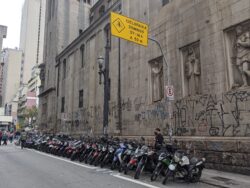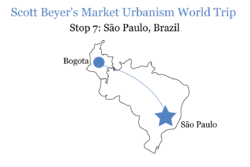The Challenge of Latin American “Centros”
Downtown areas there struggle with crime and obsolescence. What can bring them back?
Travel through Latin America’s major cities, from CDMX to Buenos Aires, and one finds a paradox. Their historic downtowns, or centros, are full of landmarks—parks, historic churches, plazas, civic institutions. They are major activity hubs and should have high property values. Yet they simultaneously are marred by crime and blight, and locals often don’t consider them the “heart” of their city. The causes are varied, speaking to one of the biggest challenges in LatAm urbanism.
Sao Paulo’s centro in particular was the worst I’ve seen. Last October I booked a room in a somewhat-upscale U.S. hotel brand, in an area near centro described by tourist websites as “historic”. The decision to locate centrally was intuitive—after all most U.S. big city “downtowns” have revived and become places for institutional investment. But centro Sao Paulo, despite having people and commerce, was like a giant skid row—one local later called it “zombieland”. It was plagued for many square kilometers with trash piles, homeless encampments and graffiti. The most searing memory of the area was seeing a beautiful cathedral tagged all over.

But Sao Paulo wasn’t the only example, just the worst one. In Montevideo’s core it seemed about half the stores were vacant. In centro Medellin and Bogota there was open prostitution. In Guatemala City’s Zona 1, even small stores had guards bearing assault rifles.

In anecdotal observations from locals and development experts, I heard reasons similar to those which caused U.S. downtown areas to decline (before their 21st-century revival).
The main one is increased competition from elsewhere. While centros remain working-class, LatAm’s affluent flee for greener pastures. It’s not that everyone wants sprawling U.S.-style suburbs (although many do); they also seek newer areas within city propers.
In centro Sao Paulo, as with American cores, auto-oriented government plans played a heavy role in the decline, according to the Institute for Transportation and Development Policy (ITDP), “drawing out the lifeblood of the old city in the process.”
But as the centro declined, nearby Paulista Avenue emerged as a new center. As Francesco Perrotta-Bosch writes for Architectural Review, the corridor was modeled after Parisian thoroughfares and intersects many streets, giving it a natural advantage in terms of urban activity. When the city lifted height limits beyond the old centro in the mid-20th century, Paulista hosted a building boom. Suburbanization of the wealthy in this case aided urbanization, as mansions were sold and the lots redeveloped. The financial sector moved their operations there and a subway bolstered the corridor’s fortunes. ITDP writes that this development extended elsewhere in Sao Paulo, “creating new centers of development every 10 to 20 years” (to that point, I noticed some decline starting to happen along Paulista, too).
Medellin’s Poblado neighborhood fills this “replacement” role also, while tourism blogs warn against the centro, despite it being once-affluent and still having the Museo de Antioquia and the Catedral Metropolitana. When Guadalajara’s historic core fell into disrepair, a newer, wealthier enclave called Puerta de Hierro attracted the wealthy. My cab driver in Quito claimed that just in his lifetime, the “cool” part of town had shifted three times within city boundaries.
Relatedly, the second reason for centro decline is obsolescence. Some of this is organic—as buildings get old they lose appeal and become expensive to maintain. But city governments add to the problem. Robert Quevedo, an architecture professor in Guatemala City, spoke of the nightmare with one property he owns in Zona 1. The city’s preservation overlay has effectively made it impossible for him to build anything. He says, repeating a common scenario in the U.S., that this has driven Guatemalan developers to other neighborhoods and suburbs where they face less regulations.
A third problem is crime. To an extent, every LatAm neighborhood and city struggles with crime in a way unfamiliar to most Americans. But it gravitates to centros especially; there are many low-income people who rely on social services, and still lots of high-income people too, namely tourists. I’ve found this has made them havens for pickpockets and drug dealers. Contrast this with newer areas that have sophisticated private security setups.
*
It’s tempting to think that LatAm centros are outdated and destined to fail. But I don’t view it as inevitable.
There does, however, need to be an attitude shift. In a competitive landscape, where increasingly-wealthy LatAm consumers have many living options, centros must tap into their strengths. This will likely require more privatization—private security, private street management, and other measures that in the U.S. are often outsourced to business coalitions. It will also require deregulating development to allow more adaptive reuse of old buildings.
At bottom, centros should be treated like the cultural gems they are, by shifting stewardship away from government bureaucracies that have let them go to seed.
All images credited to Scott Beyer and The Market Urbanist.
Catalyst articles by Scott Beyer | Full Biography and Publications
